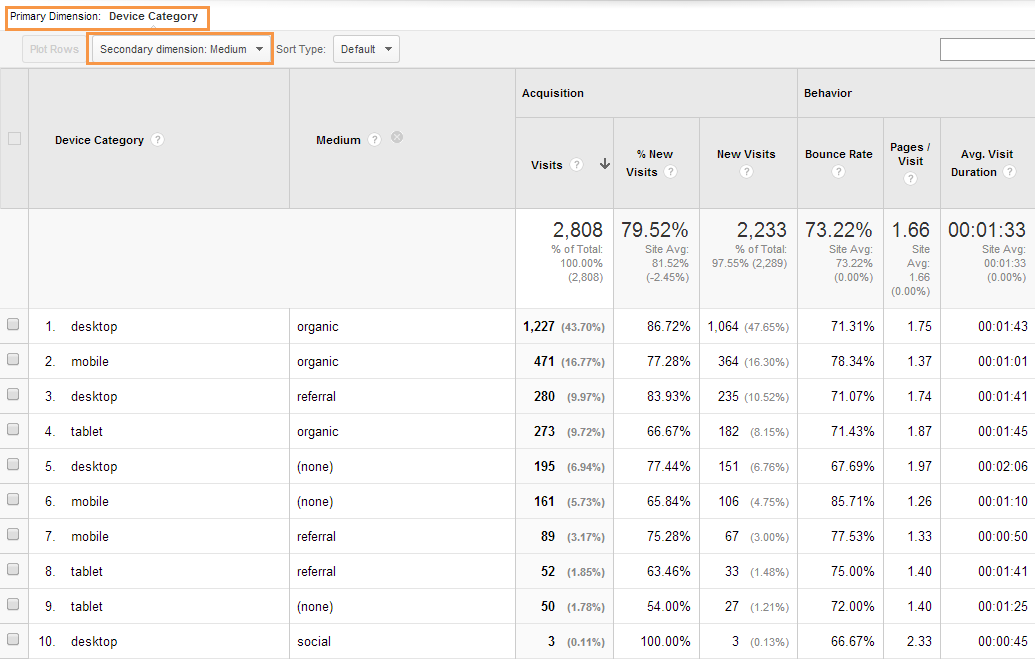Comprehensive Insights Making Use Of Secondary Dimension in Google Analytics
Wiki Article
Transform Your Analytics Approach With Second Measurement in Google Analytics
Checking out the capacity of second measurements in Google Analytics opens up a realm of possibilities for companies seeking to elevate their analytical approach. By integrating secondary dimensions right into information analysis, a new layer of insights arises, shedding light on intricate user behaviors and interactions. This innovative degree of scrutiny not only improves marketing strategies however likewise deciphers concealed opportunities for optimization and development. The calculated application of additional dimensions holds the key to unlocking a bonanza of invaluable details that can change just how companies interpret and act upon their information.Understanding Second Dimensions in Google Analytics
Additional measurements in Google Analytics offer additional context to main data by permitting users to evaluate metrics throughout a second dimension, supplying deeper insights into individual actions and interactions on a website. Secondary Dimension in Google Analytics. While main measurements provide essential information factors such as pageviews, bounce price, and session period, secondary dimensions use an even more comprehensive sight by segmenting the key information better. This segmentation enables customers to analyze metrics in combination with one more measurement, such as website traffic sources, demographics, or customer habitsAdvantages of Using Secondary Dimensions
Using additional measurements in Google Analytics supplies a tactical advantage by improving the depth of analysis and supplying an extra extensive understanding of user interactions and habits on an internet site. By including secondary dimensions, experts can obtain valuable understandings right into the efficiency of details sectors or variables within their information. This makes it possible for an extra detailed examination of customer actions past surface-level metrics, permitting a much deeper expedition of the variables affecting individual interaction and conversions.
Just How to Carry Out Second Measurements
When including secondary measurements in Google Analytics, one necessary action is to select the appropriate metrics and measurements to enrich the analysis process. Clicking on this switch will certainly open a drop-down menu listing numerous dimensions that can be added to your main measurement for much deeper insights.After selecting the proper secondary dimension, such as 'Source/Medium' why not find out more or 'Tool Group,' Google Analytics will display the information in an extra detailed format, enabling you to cross-analyze various facets of customer behavior. Keep in mind to experiment with different combinations of additional and key measurements to uncover useful patterns and patterns that can notify your advertising strategies. By executing secondary measurements attentively, you can obtain an extra thorough understanding of your website or app performance and make data-driven decisions to optimize your digital existence.
Analyzing Information With Secondary Measurements
Boost your data evaluation in Google Analytics by integrating additional measurements to dive deeper into user behavior patterns and maximize your digital advertising strategies effectively - Secondary Dimension in Google Analytics. By including additional dimensions to your key information, you can gain beneficial insights that can help you make notified decisions concerning your internet site or app performance
Evaluating data with second dimensions permits you to section your primary information additionally, offering a more thorough sight of customer communications. Integrating the primary measurement of 'source/medium' with a secondary dimension like 'touchdown page' can expose which specific pages are driving web traffic from various sources. This info can be instrumental in improving your content method or maximizing your marketing campaign to boost conversions.
Moreover, using second dimensions allows you to identify relationships between various metrics, helping you comprehend the influence of various aspects on individual actions. Whether it's evaluating demographics along with user interaction metrics or tool groups with conversion rates, secondary measurements empower you to discover covert trends and patterns that can direct your advertising and marketing initiatives.
Enhancing Performance With Additional Measurements
To improve the performance of information analysis and decision-making in Google Analytics, integrating additional measurements is crucial to maximizing efficiency metrics and gaining much deeper insights into individual actions patterns. By making use of second measurements, analysts can delve beyond surface-level data and uncover valuable connections that may otherwise go unnoticed. This optimization strategy enables businesses to customize their advertising and marketing initiatives extra properly, recognize locations for enhancement in site usability, and enhance overall user experience.Additional dimensions provide a more comprehensive sight of individual interactions by offering additional context to primary information metrics. For instance, matching have a peek at this website the main dimension of 'landing web page' with an additional dimension like 'device group' can expose whether certain gadgets are extra likely to drive engagement on details touchdown pages. This insight can educate responsive layout renovations or targeted advertising strategies to increase efficiency.

Verdict
To conclude, the integration of secondary measurements in Google Analytics offers companies with an effective tool to enhance their analytics method. Secondary Dimension in Google Analytics. By delving deeper right into individual actions and communications, online marketers can uncover valuable insights that can drive performance optimization and enhance the overall individual experience. Leveraging secondary measurements enables a more detailed analysis of information, leading to even more informed decision-making and next page customized advertising initiativesSecondary measurements in Google Analytics provide extra context to primary information by allowing individuals to assess metrics across a 2nd dimension, using deeper understandings into individual actions and interactions on a web site. While key dimensions supply basic data points such as pageviews, bounce price, and session duration, additional measurements offer a more thorough view by segmenting the main information further.One of the essential advantages of making use of secondary dimensions is the capability to reveal connections and patterns that might not be right away noticeable when analyzing data with main measurements alone.When incorporating additional measurements in Google Analytics, one essential step is to choose the pertinent metrics and dimensions to enhance the evaluation procedure. Pairing the primary dimension of 'touchdown web page' with a second measurement like 'tool group' can reveal whether certain tools are a lot more most likely to drive involvement on certain touchdown web pages.
Report this wiki page